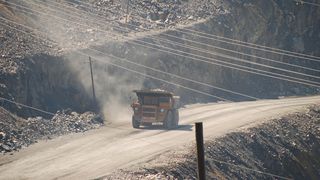USSC contributor David Uren penned this op-ed published by The Australian Financial Review as a follow up to his research report Rare earths: Is there a case for government intervention?
In principle, its the perfect match. The US military has a great need for critical minerals and is concerned that too many of its supplies are sourced from China and Russia. Australia has delivered an intelligent strategy to support the development of Australia’s rare earths and other critical mineral resources.
But the federal government has struggled to get a complementary commitment from the United States.
Australia has abundant resources and companies keen to develop them if only they could secure the sales contracts needed to underwrite the project finance.
But the big thing Australian critical mineral resource projects are looking for – firm sales contracts – remains elusive. In the absence of secure sales, projects can access neither equity nor bank finance.
The US military has a great need for critical minerals and is concerned that too many of its supplies are sourced from China and Russia.
Both sides are talking. The US-Australia Critical Minerals Dialogue convened in Washington last week with high-level representation from the US, including Commerce Secretary Wilbur Ross, while Australia sent Resources Minister Matt Canavan. There will be another round of talks next February.
Canavan did not return empty-handed. A partnership has been formalised between Geoscience Australia and the United States Geological Survey to share information. And officials agreed that the Export Import Bank of the United States would work with Export Finance Australia on financing potential critical minerals projects.
The risk of political disruption to the supply chain is real. In 2010, China squeezed supplies of rare earths to the world market in part to punish Japan during a dispute over the sovereignty of uninhabited islands. Global prices for rare earths – the set of 17 closely related minerals with widespread high-technology applications – were sent skyrocketing, rising as much as tenfold.
However, the only non-Chinese company to develop significant rare earth production following that episode was Australia’s Lynas. It succeeded solely because the Japanese government-orchestrated concessional finance and guaranteed sales contracts and had the patience to wait years for it to get its Malaysian processing plant working adequately.
Australia has abundant resources and companies keen to develop them if only they could secure the sales contracts needed to underwrite the project finance.
Industry department secretary Heather Smith told a recent conference organised by the Perth USAsia Centre that the market for critical minerals was a “conundrum”. Despite the ubiquitous use of critical minerals and their economic and strategic importance, the market for them was immature.
Users appear to give insufficient weight to the diversity of supply and competition, despite the strategic importance of end products for which critical minerals are an irreplaceable input.
History shows that the presence of monopolies impedes the creation of opportunities, innovation and the flow of wealth, and this may be a factor in the critical minerals industry, she said.
If it were simply an economic issue, policymakers would focus on market solutions, with a greater emphasis on transparency and competition policy. But Smith argued that if risks to the supply of critical materials were strategic in nature, the case for government intervention became stronger.
The issue was close to the top of the agenda when former Prime Minister Malcolm Turnbull travelled to the United States for talks with Donald Trump in February last year. A few months earlier, Trump had declared that the US dependence on Chinese and Russian supplies represented “a strategic vulnerability for both its economy and military to adverse foreign government action”.
Turnbull established an inter-departmental taskforce, led by the then head of his department, Dr Martin Parkinson, and its response was released this month. Companies in the critical minerals sector will be able to access finance from Export Finance Australia (EFA). Miners with military-related sales contracts will be able to tap the agency’s special $3.8 billion defence exports facility which can finance “non-commercial” ventures with the risk being borne by the federal government, rather than the agency.
Companies will be able to get finance from both EFA and the Northern Australia Infrastructure Facility. An office will be established within the Department of Industry to help firms coordinate their funding requests, which are expected to include base project funding. For rare earths projects, that can run to $1 billion or more.
But will the US defence contractors switch their preferred supplies from China to Australia? Partly because of the incredibly diverse range of uses of critical minerals – there are 3300 items of US military equipment that will not work without rare earths – supplies are extremely fragmented. A report by the US General Accounting Office commented that defence needs for rare earths represent only 1 per cent of total US demand, so defence suppliers may not have the scale to underwrite new projects.
Moreover, buying critical minerals is not like buying copper or gold: the exact specifications of products are crucial and can be difficult to achieve, so customers are wary of committing to new supplies.
While US officials wrestle with their President’s demand for action, they have not found a strategy to channel demand our way.






